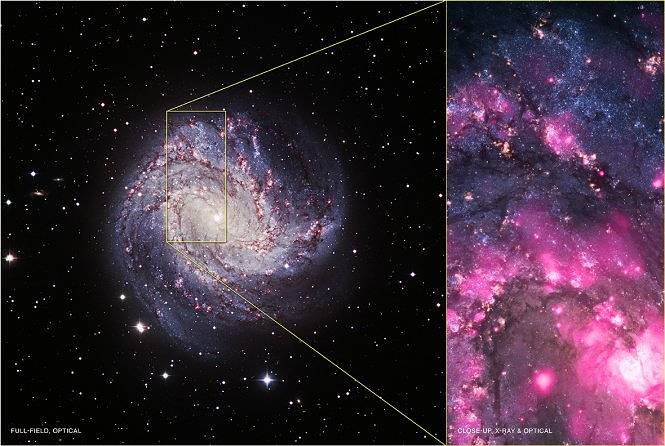
NASA’s Chandra X-ray Observatory has discovered an extraordinary outburst by a black hole in the spiral galaxy M83, located about 15 million light years from Earth. Using Chandra, astronomers found a new ultraluminous X-ray source (ULX), objects that give off more X-rays than most “normal” binary systems in which a companion star is in orbit around a neutron star or black hole.
On the left is an optical image of M83 from the Very Large Telescope in Chile, operated by the European Southern Observatory. On the right is a composite image showing X-ray data from Chandra in pink and optical data from the Hubble Space Telescope in blue and yellow. The ULX is located near the bottom of the composite image.
In Chandra observations that spanned several years, the ULX in M83 increased in X-ray brightness by at least 3,000 times. This sudden brightening is one of the largest changes in X-rays ever seen for this type of object, which do not usually show dormant periods.
Optical images reveal a bright blue source at the position of the ULX during the X-ray outburst. Before the outburst the blue source is not seen. These results imply that the companion to the black hole in M83 is a red giant star, more than about 500 million years old, with a mass less than about four times the Sun’s. According to theoretical models for the evolution of stars, the black hole should be almost as old as its companion.
Astronomers think that the bright, blue optical emission seen during the X-ray outburst must have been caused by a disk surrounding the black hole that brightened dramatically as it gained more material from the companion star.
Another highly variable ULX with an old, red star as a companion to a black hole was found recently in M31. The new ULXs in M83 and M31 provide direct evidence for a population of black holes that are much older and more volatile than those usually considered to be found in these objects.
The researchers estimate a mass range for the M83 ULX from 40 to 100 times that of the Sun. Lower masses of about 15 times the mass of the Sun are possible, but only if the ULX is producing more X-rays than predicted by standard models of how material falls onto black holes.
Evidence was also found that the black hole in this system may have formed from a star surprisingly rich in “metals”, as astronomers call elements heavier than helium. The ULX is located in a region that is known, from previous observations, to be rich with metals.
Large numbers of metals increase the mass-loss rate for massive stars, decreasing their mass before they collapse. This, in turn, decreases the mass of the resulting black hole. Theoretical models suggest that with a high metal content only black holes with masses less than about 15 times that of the Sun should form. Therefore, these results may challenge these models.
This surprisingly rich “recipe” for a black hole is not the only possible explanation. It may also be that the black hole is so old that it formed at a time when heavy elements were much less abundant in M83, before seeding by later generations of supernovas. Another explanation is that the mass of the black hole is only about 15 times that of the sun.
Credits: Left image – Optical: ESO/VLT; Close-up – X-ray: NASA/CXC/Curtin University/R. Soria et al., Optical: NASA/STScI/Middlebury College/F. Winkler et al.› Read more/access all images


























